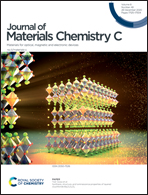Surface lattice reconstruction enhanced the photoresponse performance of a self-powered ZnO nanorod arrays/Si heterojunction photodetector
Abstract
Self-powered photodetectors (PDs) have attracted much attention due to their merit of working without an external power source. Performance enhancement is favorable for their development and practical applications. In this work, a clear and compact ZnO crystal shell layer is created on the surface of ZnO nanorods by using a surface lattice reconstruction technique through triethylamine treatment. After surface lattice reconstruction, the self-powered photoresponse performance of the ZnO NRAs/p-Si heterojunction PD was thus significantly improved by 2 orders of magnitude for 365–950 nm broadband light. Under 950 nm light at 2 μW cm−2, the self-powered PD demonstrated an excellent responsivity of ∼5.36 A W−1 and a detectivity of ∼6.99 × 1014 jones. The results indicate that the compact ZnO crystal shell layer reduces surface oxygen vacancies and dangling bonds, improves light absorption and reduces charge carrier recombination. The strategy provides an approach to design and fabricate other metal–oxide–semiconductor-based self-powered PDs with high performance.



 Please wait while we load your content...
Please wait while we load your content...